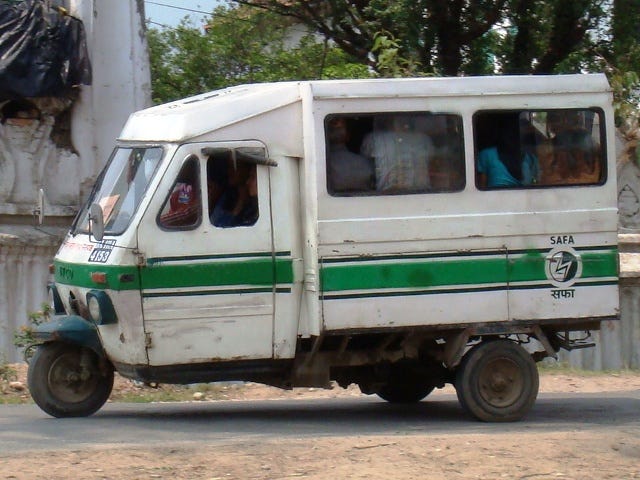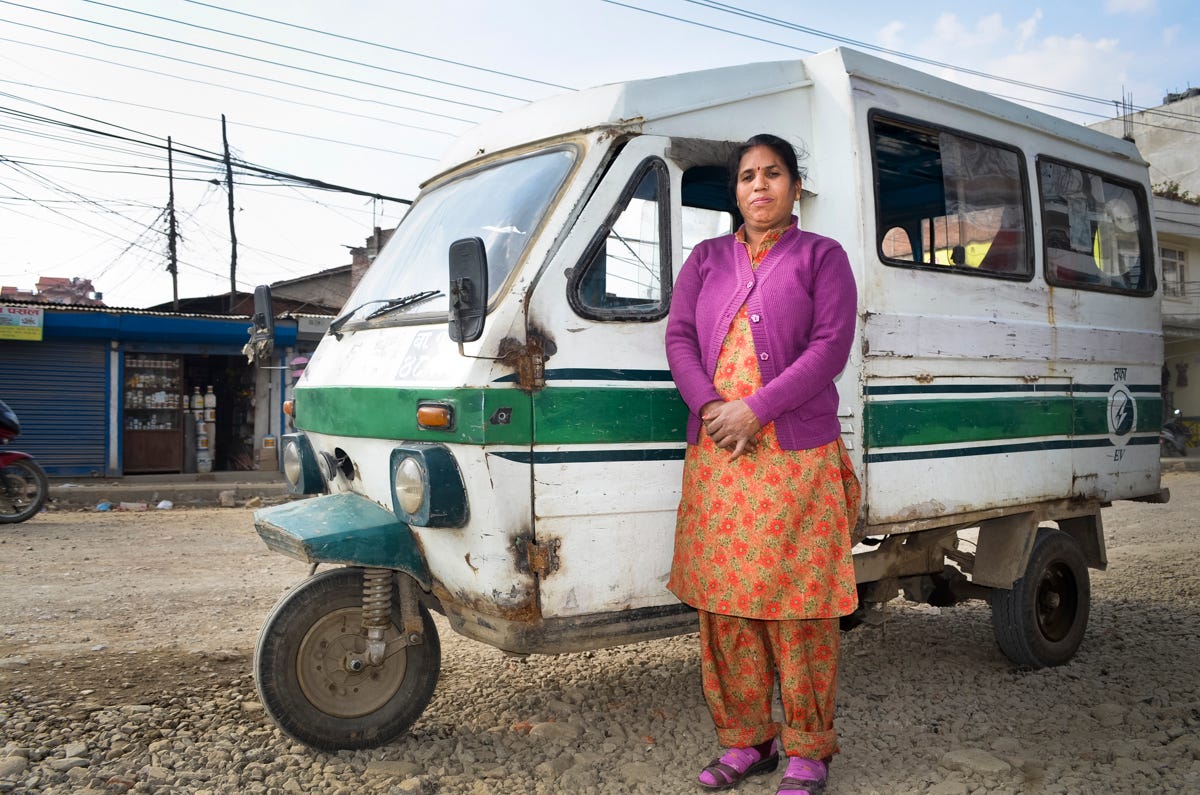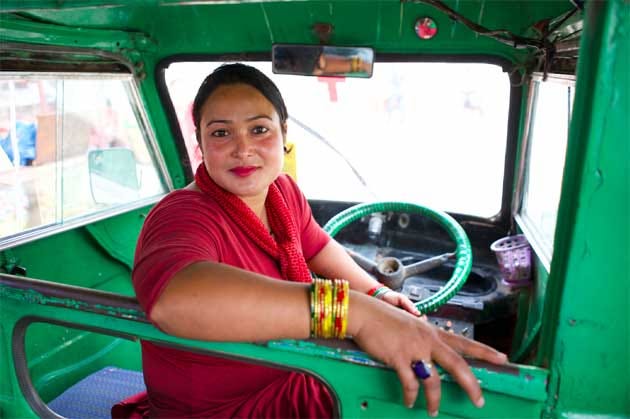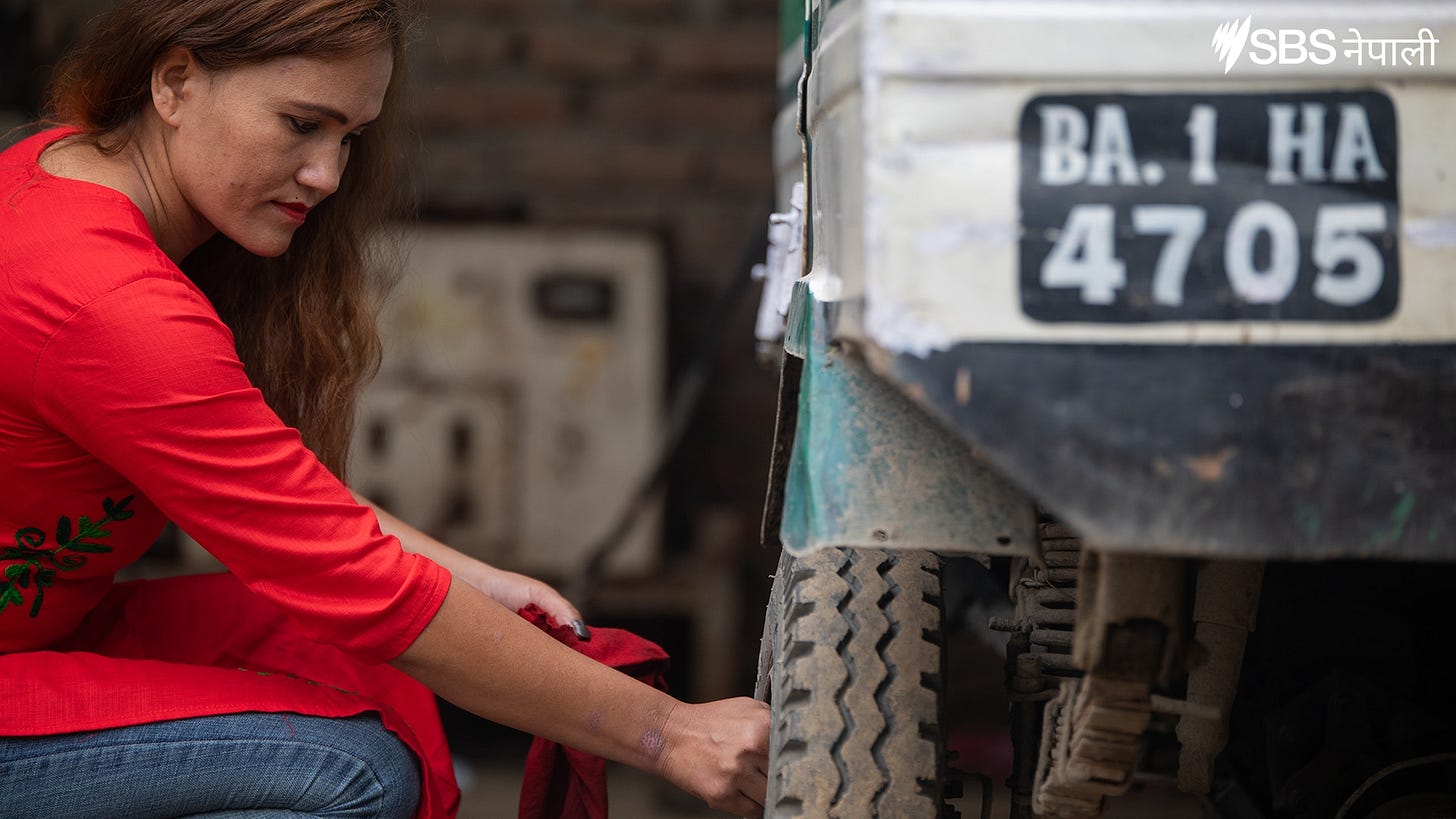Hey there,
I hope this email finds you well.
Here’s your fortnightly dose of Makeshift Mobility, your first newsletter focused on innovations in informal transportation. (Head over to my friends at Pop Transport if you want more.)
This week we dive into the सफा टेम्पो or the Safa Tempo, Kathmandu’s electric three-wheeler that was way ahead of its time.
(I credit this issue to my friend Dinna Dayao who first brought Safa Tempos to my attention.)

Name Game
Tempo (ṭēmpō) is just the generic name for three-wheelers in Nepal. Safa (saphā) means “clean.” It’s called a clean three-wheeler to differentiate it from the other tempos on the Nepali roads which run on diesel, CNG, or petrol.
Safa Tempos carry 10 passengers in the back with the driver riding solo in front, sort of like a supersized vikram. It’s more of a minibus than an auto rickshaw.
Unlike the vikram, you board from the back of the Tempo the way you would a jeepney in Manila.
There’s something about the 10-12 passenger number that seems to work for informal transportation. Remember Jakarta’s angkot carry about the same?
Wilbur Sargunaraj takes us on a look-see of a Safa Tempo.
Safa Tempos have been around for nearly three decades. How they came to be and how they were introduced to Kathmandu is a story of vision and advocacy. The story involves geopolitical forces, environmentalism, international city relationships, and innovative women working leading the way for women’s empowerment.
I’ll tell you more about the backstory but let’s start with some poetry. This one’s from Bhuwan Thapaliya (भूवन थपलिया).
Safa Tempo
In the ‘Safa Tempo’
everyday whistles
a chilled
exhaustion
of human struggle
for survival.
Everyday the smell of
a burnt human hope
mingles with
the unwashed dreams,
reeking old sweat
and limp manure
of the commuters’
unfufilled wishes.
Safa Tempo,
a metaphor of survival
reminding me
of my villages I had left behind, the lips I’ve yet to kiss.
Thapaliya is a Nepali poet and economist from Kathmandu. Safa Tempo is from his recently released book: Safa Tempo: Poems New and Selected. You can catch more of Thapaliya’s poems and more about him from this interview with the Poet Magazine.
Not automatic
I like Thapaliya’s line “the unwashed dreams” which, IMHO, captures so much of the essence of informal transportation: the everyday-ness; the dreams; and the absent minded day dreaming. The struggle.
Did you catch that?
The Safa Tempo is an electric vehicle but an electric vehicle doesn’t automatically improve the conditions of informal transportation.
It’s a point my colleagues at the Global Partnership for Informal Transportation like to make: vehicle electrification is not enough. We have to understand the systems that shape and drive informal transportation if we are to transform makeshift mobility.
Informal transportation also gives us the opportunity for a Just Transition, but only if we think beyond the electric vehicle.
Our hero’s origin story
So how did the Safa Tempo come to be?
Sushila Maharjan has about the best recounting of the history of the Safa Tempo in her 2002 paper for her masters from MIT’s Department of Urban Studies and Planning.
The Safa Tempo’s backstory starts with India’s 1989 economic blockade of Nepal. The NYTimes reports on the mise en scène in 1989:
Nepal, wedged between China and India, the world's two most populous nations, has only one reliable outlet to the sea, overland through the Indian port of Calcutta, more than 700 miles away.
On March 23, after a dispute over how to renegotiate lapsed trade and transit treaties, New Delhi suddenly closed 19 of 21 border crossings with this Himalayan nation, severing links not only to the port but also to northern Indian cities.
The squeeze caused turmoil in Nepal. “Lines at gas stations are long, straining tempers. The streets of Katmandu, the capital, are nearly devoid of cars, and travel around Nepal by air or bus is becoming more difficult. Forests are being stripped for cooking fuel.”
The country began exploring alternative fuels and this lined up with a growing concern for air pollution in Kathmandu. The city tried to create an electric vehicle industry, first experimenting with an electrified VW Beetle. They got a running model but not a market.
Electric Power
In 1990, the Kathmandu-Eugene City Committee, led by a husband and wife team of Peter Moulton and Marily Cohen, proposed converting the existing tempos in Kathmandu to electric vehicles. Nepal is rich in hydro-power so this was an appealing way forward. It would reduce the country’s dependence on imported fuel (which India was squeezing) and the zero-emissions vehicle would improve air quality.
Moulton and Cohen formed the Global Resources Institute (not to be confused with the World Resources Institute). With funding from USAID and using off-the-shelf parts, GRI began the development of an electric tempo -the Safa Tempo.
BTW, I’m loving the 90s vibe on that GRI website. I checked the code and it is authored on Microvision WebExpress, an application (they didn’t call them “apps” back then) that ran on Windows 95 and 98.
The 90s are calling, they want their HTML code back. (Btw, I coded my first website in 1993 using HotDog.)
In 1993, GRI delivered seven Safa Tempos to Kathmandu. The tempos ran (and still run) on old style, deep-cycle lead acid car batteries - three at a time, with six in total on board.
Those batteries are heavy (350kg) and take up half the vehicle’s load. Three batteries gave the vehicle 72 volts, a range of 60km on one charge (and one set), and a top speed of 45km/hr.
GRI ran a demonstration for six months, ferrying more than 200,000 passengers over 175,000 kilometers. Declaring it a success, the government mobilized the private sector to begin manufacturing more Safa Tempos.
Sushila Maharjan recounts:
The Nepal Electric Vehicle Industry (NEVI), comprised of environmentalists, journalists, engineers and business people, became the first private sector company. NEVI, in general, functioned within the integrated business model, manufacturing, operating, and servicing its vehicles. The other company that emerged at the same time was Electric Vehicle Company (EVCO). EVCO focused more on the manufacturing aspects of the industry. These investors were motivated to make a profit, but at the same time they were eager to improve air quality in the [Kathmandu] Valley.
Through a combination (not always purposeful or successful) of incentives and regulations, advocates pressured the Kathmandu government to create the economic space to support electric vehicles in general and the Safa Tempo in particular.
Danish aid agency DANIDA took over from USAID and supported the scaling of the industry.
By the early part of the aughts, there were more than 600 Safa Tempos serving Kathmandu. But, after this rapid explosion, the growth would slow. Now there are little less than 700 Safa Tempos in the city, serving 17 routes.
What’s amazing is that half of those Safa Tempos are driven by women.
Woman Power

The Safa Tempos opened the way for Nepali women to become drivers and gain economic power.
Usha KC from the Global Press Journal tells us about Laxmi Sharma:
Today, hundreds of female tempo drivers ply the streets of Kathmandu, Nepal’s capital. The woman who paved the way for all of them is Laxmi Sharma, Nepal’s first female tempo driver.
“Every day, I had to fight battles in this male-dominated profession,” says Sharma, 65. “It was very frustrating to hold my ground in this patriarchal society. But I was strong-willed, and I never gave up.”
…At the time, some Nepalese women drove their private vehicles, but Sharma was the first woman to drive a vehicle used by the public, she says.
Driving a tempo brought Sharma economic independence and opened the door for other women, she says. But challenging Nepalese gender stereotypes also brought her many hardships.
“At the time I started to drive the tempo, women did not come out to work in public places,” Sharma says. “Back then, a woman riding a tempo, collecting the fare, and repairing the vehicle by herself was unusual and challenging work.”
When Sharma started driving a tempo, some people questioned her moral character, she says. Men harassed her — making sexual innuendos, pulling her hair, even trying to touch her. Sometimes even female passengers refused to pay the fare because, as a woman, she posed no threat.
Laxmi persisted and prevailed.
With the right supports, informal transportation does create opportunity for women.
Here’s another short video (2:30), this time about another Nepali woman and her rickshaw.
Lilawati doesn’t drive a Safa Tempo and she’s in another city (Janakpur) but listen to her story of independence and empowerment.
Women powered innovation
There’s more women power driving innovation around Safa Tempos.
Sonika Manandhar is the 2019 UNEP Champion of the Earth (Asia).
Sonika and Tiffany Tong co-founded Aeloi Technologies, a fintech organization that helps fund women micro-entrepreneurs using digital tokens. Aeloi runs Green Energy Mobility, a micro-impact investing platform which aims to accelerate electric vehicle adoption.
Sonika’s story weaves in how credit and finance has a role to play in transforming makeshift mobility.
The [GEM] network aims to provide three key solutions: first, to make electric transport a safe, clean and affordable option for commuters in Kathmandu and a more viable income earner for safo-tempo drives, mostly women.
Second, to help safa-tempo upgrade their vehicles to buy new lithium ion batteries which last a full day. Safa-tempo batteries need frequent charging, resulting in lost business during peak commuting hours. The system connects drivers with banks, helping them access loans.
And third, to gather data through the platform to predict and cut traffic congestion and in the long-term, help to plan more efficient cities. This is done using a system of digital tokens, bought from approved vendors. The tokens allow digital transaction of payments and tracking of data.
Counterpunch 1: Credit

There’s always a villain or two and not all is rosy for Safa Tempos.
The government hasn’t reinvested in the space and actually opened the door for diesel minibuses.
Safa Tempo’s technology and vehicles are showing their age. They could be upgraded (with lithium ion tech, for instance) but the informal nature of makeshift mobility means the drivers and operators can’t access credit.
IPS tells us more how Sonika, Tiffany, and GEM are trying to meet that challenge:
Initial online research showed us that the number of safa tempos had not increased since the mid-2000s. Curious about the reason, we started interviewing a lot of safa tempo drivers and owners to understand their challenges. We found out that actually there are an estimated 100 safa tempos just sitting and slowly rusting in garages. It was a sad sight to behold.
The reason behind this is that one of the main challenges for safa tempo owners and drivers is to upgrade their battery and engine technology. For example, the owners often buy a pair of lead acid batteries that last only 1 to 1.5 years. This costs about US$4500. Lithium ion batteries that last 5-8 years are available and the technology is quite mature, but they cost almost US$10,000, which is completely out of reach for most women employed in the informal sector. So if an owner cannot afford a new set of batteries, they tend to leave the safa tempo at a garage because it is not worth the loan amount and interest rates. The interest rates can go as high as 26% p.a., depending on if the borrower has any collateral or credit history. If the owners have to take credit from loan sharks, then the interest rates are unpredictable and can go as high as 120% p.a. Often, they can’t access any loan, even with very high interest rates.
Counterpunch two: COVID

Amongst the approximately 700 such tempos in Kathmandu valley, almost half are driven by women. Most of these female drivers are either poor, with low literacy or are migrant workers coming to the capital to earn a daily wage.
Devi Shrestha, from Sindhupalchowk, a remote district near the capital, was barely literate when she came to Kathmandu in 2002. The only education she had received until then was three months of adult education classes and could just read simple words.
Married at the age of 14, she came to Kathmandu when she was 17. After having worked in various places, Ms Shrestha was attracted to the idea of driving tempos, after seeing many women involved in that profession.
That was 15 years ago. She then went on to learn to drive with the help of her friends and got her drivers license. Eight years ago, Shrestha took out a loan to buy her own Tempo.
…"I tried working at a garment factory and a hotel. There I earned around $15 to $20 per month. When I remember those days of struggle, I realize how the tempo has helped me become independent," she says.
"Tempo driving has not only helped me run my household but also educate my son and my daughter."
The Electric Vehicles Association of Nepal says that its repeated motivational efforts to promote female tempo drivers has resulted in a high number of women joining the industry.
“Safa tempo is lightweight and is easy to operate because it has no gears. Since it runs on electricity, it is easier to repair than other vehicles,” says Umesh Shrestha, chairperson of the association.
But then;
…since the COVID-19 lockdown that began on March 24 across the country, many women gradually lost the independence they got by earning a decent wage. Many drivers who are yet to pay off their loans are now being hounded by their banks
"After paying the charging station and buying food, I send the remaining money to a finance company to pay my loans. During the lockdown, when we barely had the money for food, banks were calling us with demands to pay the loan interest and installments,” says Shrestha.
It is this kind of precarity where the government needs to step in. Where a reframing of informal transportation as asset, rather than local problem, could really help.
You can have as many zero-emission vehicles as you like, but that doesn’t mean you’ve made the system more sustainable.
Sidekicks
Ok, I’ve gone on long enough. I hope you enjoyed the Safa Tempo story. My one takeaway is that real sustainability isn’t just about electric engines -it’s about empowerment.
I leave you with a couple more quick hits:
Catch you next time. Leave me a comment.
I’m Benjie de la Peña and I’m the CEO of the Shared-Use Mobility Center. I co-founded Agile City Partners, and I am the Chair of the Global Partnership for Informal Transportation.
I was raised by powerful women, and I’m married to a very powerful woman who makes my hectic life electric and sustainable.
I’m convinced that informal transportation can be the single greatest lever to decarbonize the urban transport sector, but only if we stop ignoring it and instead learn to celebrate it so we can transform it.




